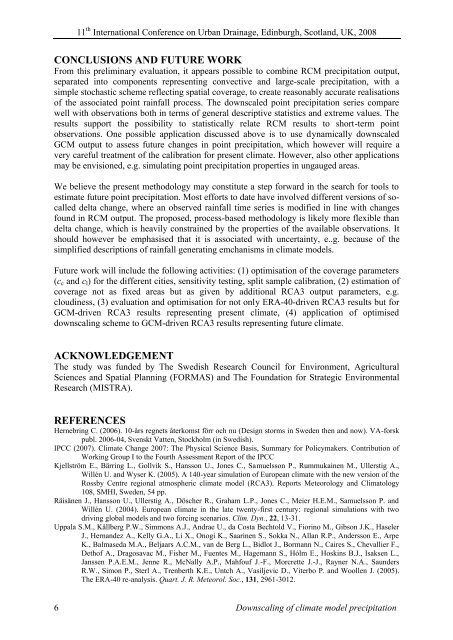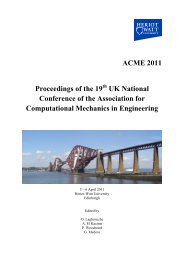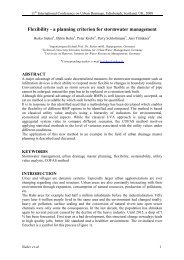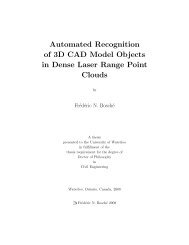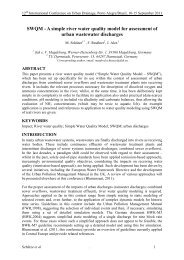Downscaling of Regional Climate Model Precipitation for Urban ...
Downscaling of Regional Climate Model Precipitation for Urban ...
Downscaling of Regional Climate Model Precipitation for Urban ...
Create successful ePaper yourself
Turn your PDF publications into a flip-book with our unique Google optimized e-Paper software.
11 th International Conference on <strong>Urban</strong> Drainage, Edinburgh, Scotland, UK, 2008<br />
CONCLUSIONS AND FUTURE WORK<br />
From this preliminary evaluation, it appears possible to combine RCM precipitation output,<br />
separated into components representing convective and large-scale precipitation, with a<br />
simple stochastic scheme reflecting spatial coverage, to create reasonably accurate realisations<br />
<strong>of</strong> the associated point rainfall process. The downscaled point precipitation series compare<br />
well with observations both in terms <strong>of</strong> general descriptive statistics and extreme values. The<br />
results support the possibility to statistically relate RCM results to short-term point<br />
observations. One possible application discussed above is to use dynamically downscaled<br />
GCM output to assess future changes in point precipitation, which however will require a<br />
very careful treatment <strong>of</strong> the calibration <strong>for</strong> present climate. However, also other applications<br />
may be envisioned, e.g. simulating point precipitation properties in ungauged areas.<br />
We believe the present methodology may constitute a step <strong>for</strong>ward in the search <strong>for</strong> tools to<br />
estimate future point precipitation. Most ef<strong>for</strong>ts to date have involved different versions <strong>of</strong> socalled<br />
delta change, where an observed rainfall time series is modified in line with changes<br />
found in RCM output. The proposed, process-based methodology is likely more flexible than<br />
delta change, which is heavily constrained by the properties <strong>of</strong> the available observations. It<br />
should however be emphasised that it is associated with uncertainty, e..g. because <strong>of</strong> the<br />
simplified descriptions <strong>of</strong> rainfall generating emchanisms in climate models.<br />
Future work will include the following activities: (1) optimisation <strong>of</strong> the coverage parameters<br />
(cc and cl) <strong>for</strong> the different cities, sensitivity testing, split sample calibration, (2) estimation <strong>of</strong><br />
coverage not as fixed areas but as given by additional RCA3 output parameters, e.g.<br />
cloudiness, (3) evaluation and optimisation <strong>for</strong> not only ERA-40-driven RCA3 results but <strong>for</strong><br />
GCM-driven RCA3 results representing present climate, (4) application <strong>of</strong> optimised<br />
downscaling scheme to GCM-driven RCA3 results representing future climate.<br />
ACKNOWLEDGEMENT<br />
The study was funded by The Swedish Research Council <strong>for</strong> Environment, Agricultural<br />
Sciences and Spatial Planning (FORMAS) and The Foundation <strong>for</strong> Strategic Environmental<br />
Research (MISTRA).<br />
REFERENCES<br />
Hernebring C. (2006). 10-års regnets återkomst förr och nu (Design storms in Sweden then and now). VA-<strong>for</strong>sk<br />
publ. 2006-04, Svenskt Vatten, Stockholm (in Swedish).<br />
IPCC (2007). <strong>Climate</strong> Change 2007: The Physical Science Basis, Summary <strong>for</strong> Policymakers. Contribution <strong>of</strong><br />
Working Group I to the Fourth Assessment Report <strong>of</strong> the IPCC<br />
Kjellström E., Bärring L., Gollvik S., Hansson U., Jones C., Samuelsson P., Rummukainen M., Ullerstig A.,<br />
Willén U. and Wyser K. (2005). A 140-year simulation <strong>of</strong> European climate with the new version <strong>of</strong> the<br />
Rossby Centre regional atmospheric climate model (RCA3). Reports Meteorology and Climatology<br />
108, SMHI, Sweden, 54 pp.<br />
Räisänen J., Hansson U., Ullerstig A., Döscher R., Graham L.P., Jones C., Meier H.E.M., Samuelsson P. and<br />
Willén U. (2004). European climate in the late twenty-first century: regional simulations with two<br />
driving global models and two <strong>for</strong>cing scenarios. Clim. Dyn., 22, 13-31.<br />
Uppala S.M., Kållberg P.W., Simmons A.J., Andrae U., da Costa Bechtold V., Fiorino M., Gibson J.K., Haseler<br />
J., Hernandez A., Kelly G.A., Li X., Onogi K., Saarinen S., Sokka N., Allan R.P., Andersson E., Arpe<br />
K., Balmaseda M.A., Beljaars A.C.M., van de Berg L., Bidlot J., Bormann N., Caires S., Chevallier F.,<br />
Deth<strong>of</strong> A., Dragosavac M., Fisher M., Fuentes M., Hagemann S., Hólm E., Hoskins B.J., Isaksen L.,<br />
Janssen P.A.E.M., Jenne R., McNally A.P., Mahfouf J.-F., Morcrette J.-J., Rayner N.A., Saunders<br />
R.W., Simon P., Sterl A., Trenberth K.E., Untch A., Vasiljevic D., Viterbo P. and Woollen J. (2005).<br />
The ERA-40 re-analysis. Quart. J. R. Meteorol. Soc., 131, 2961-3012.<br />
6 <strong>Downscaling</strong> <strong>of</strong> climate model precipitation


